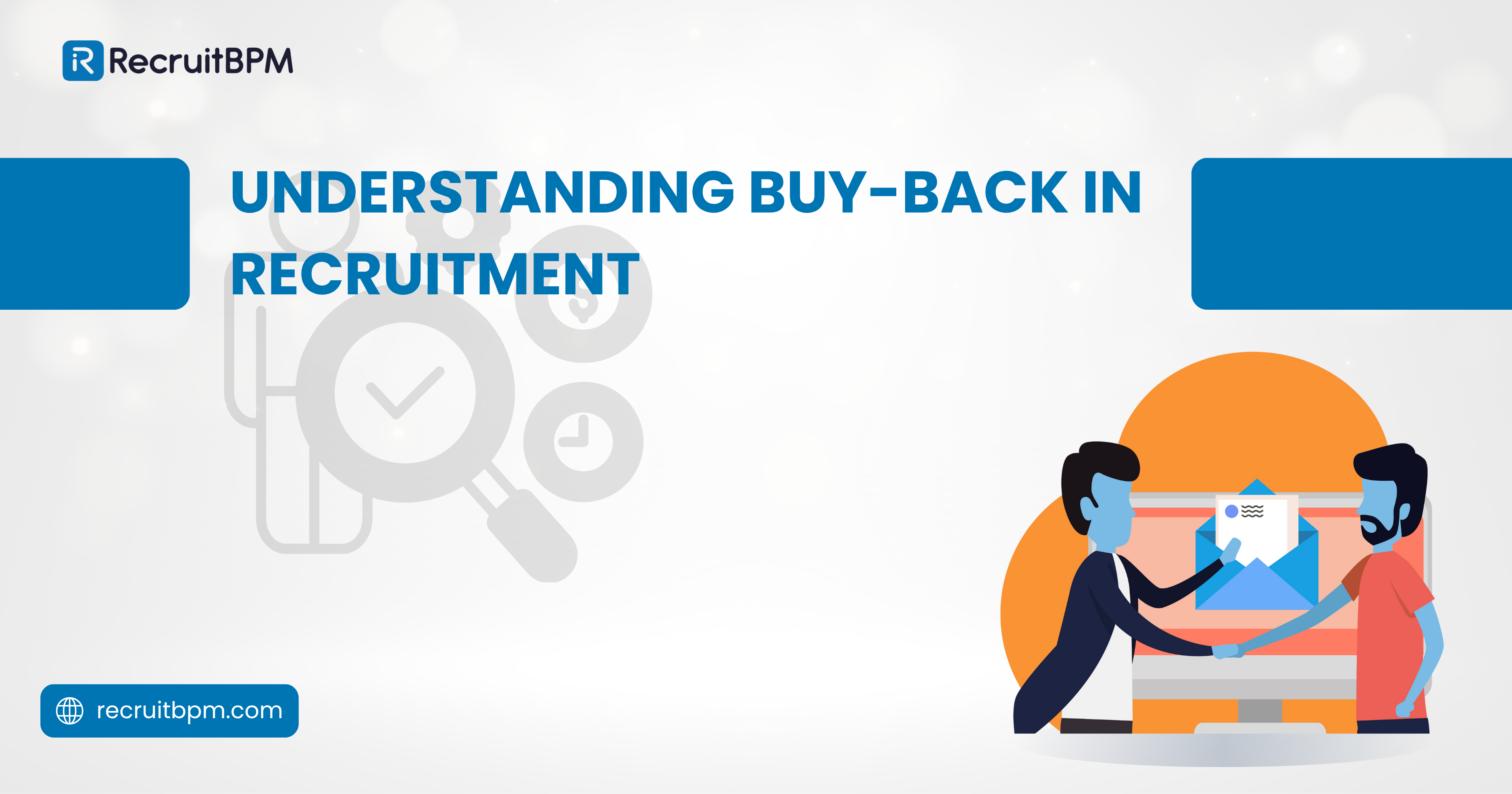Temporary placements converting to permanent hires represent one of recruitment’s most profitable scenarios. Yet without proper contractual protections, agencies lose substantial fees when clients hire temporary workers directly after short assignments end.
Buy-back clauses address this financial vulnerability by establishing clear terms and compensation structures when temporary placements transition to permanent employment. For recruitment agencies operating in temporary, contract, or temp-to-perm models, understanding and implementing effective buy-back provisions protects revenue while maintaining client relationships. Mastering the buy-back strategy separates financially secure agencies from those watching profitable conversions slip away unpaid.
What is Buy-Back?
A buy-back, also called a buyout clause or conversion fee, is a contractual provision allowing clients to hire temporary or contract workers as permanent employees by paying an agreed-upon fee to the recruitment agency that placed them. This clause establishes the financial terms under which temporary placements can convert to direct employment without violating the original placement agreement.
Conversion Fee Amount
Buy-back provisions typically specify the conversion fee amount (often calculated as a percentage of the worker’s annual salary or a flat fee), the time period during which the clause remains active (commonly 6-12 months from placement start date), conditions triggering the fee obligation (direct hire, extended contract conversion, or any employment relationship), and payment terms including due dates and any installment options.
Trigger Conditions
The buy-back mechanism recognizes that recruitment agencies invest substantial resources in sourcing, screening, and placing temporary workers. When these placements succeed, and clients wish to retain talent permanently, agencies deserve compensation for their role in creating successful matches. Without buy-back clauses, clients could simply wait for temporary assignments to end before immediately rehiring workers directly, circumventing agency fees entirely.
Payment Terms
Buy-back clauses differ from standard permanent placement fees in several ways. Permanent placements command full recruitment fees (typically 15-25% of annual salary) paid immediately upon hire. Buy-back fees are often lower (10-20% of salary), reflecting that initial temporary placement fees were already collected. The timing also differs—buy-back situations arise after employment relationships already exist, while permanent placements involve new hires. These provisions create win-win scenarios, enabling clients to retain proven performers while ensuring agencies receive fair compensation for successful placements that exceed the original temporary scope. Clear buy-back terms reduce disputes by establishing expectations before conversions occur.
Why Buy-Back Matters for Recruitment Agencies?
The staffing and recruitment industry’s financial health depends heavily on protecting revenue from successful placements that clients want to extend or convert. Buy-back provisions serve as essential risk management tools.
Revenue protection prevents substantial financial losses
Temporary placements generate ongoing markup revenue, but this income stream ends when assignments conclude. If clients immediately rehire workers directly after temporary periods end, agencies lose both ongoing markup and potential permanent placement fees. Buy-back clauses ensure agencies receive compensation when temporary success leads to permanent retention.
Temp-to-perm conversions represent common industry practice
Many temporary placements are essentially extended interviews where clients evaluate workers before permanent commitments. Industry data shows significant percentages of temporary placements eventually convert to permanent roles. Without buy-back protections, agencies facilitate these evaluations without capturing conversion value.
Client relationships benefit from clarity
Ambiguity about conversion rights creates awkward situations when clients want to retain temporary workers. Well-drafted buy-back clauses eliminate this awkwardness by establishing clear expectations upfront. Clients appreciate knowing exactly what permanent retention costs are rather than negotiating during emotional decisions about valued team members.
Competitive positioning improves through reasonable terms
Recruitment agencies offering transparent, fair buy-back provisions compete more effectively than those with restrictive or ambiguous conversion policies. Reasonable buy-back fees (10-15% of salary) position agencies as partners rather than adversaries in talent retention decisions.
Cash flow predictability increases
While temporary placements provide steady markup income, permanent placement fees deliver larger lump sums. Buy-back provisions create predictable conversion revenue when temporary assignments succeed, smoothing cash flow patterns and enabling better financial planning.
Legal clarity reduces dispute risk
Without written buy-back terms, conversion situations devolve into arguments about whether clients violated placement agreements. Documented buy-back clauses provide legal clarity protecting agency interests while reducing litigation risk that damages client relationships and generates legal expenses.
Market flexibility accommodates client preferences
Different clients prefer different hiring approaches. Some want permanent placements immediately; others prefer temporary evaluation periods. Buy-back provisions enable recruitment agencies to serve both preference types through a single contractual framework, expanding the addressable market.
Candidate experience improves through conversion pathways
Temporary workers often hope for permanent opportunities. Buy-back provisions that facilitate conversion create positive candidate experiences when temporary assignments succeed. This candidate satisfaction generates referrals and repeat business from placed talent.
How to Use Buy-Back Effectively?
Implementing buy-back provisions successfully requires thoughtful contract design, clear communication, consistent enforcement, and balanced approaches that protect agency interests while remaining fair to clients and candidates.
Include buy-back clauses in all temporary placement agreements
Never place temporary workers without documented buy-back terms. Attempting to negotiate conversion fees after clients decide to hire workers permanently creates adversarial dynamics and weak negotiating positions. Upfront clarity protects all parties.
Structure fees reasonably relative to permanent placement rates
Buy-back fees typically range from 10-20% of annual salary, lower than standard permanent placement fees (15-25%) since temporary markup revenue was already collected. Excessively high buy-back fees discourage conversions clients would otherwise pursue; too-low fees fail to compensate adequately for agency value.
Define time periods clearly with sliding scales
Many buy-back clauses use declining fee structures over time. Early conversions (months 1-3) might command 20% fees, mid-term conversions (months 4-6) drop to 15%, and late conversions (months 7-12) charge 10%. This structure acknowledges that longer temporary periods reduce agency recruiting contribution to ultimate permanent success.
Specify what constitutes “employment” triggering fees
Buy-back obligations should activate whenever clients employ workers in any capacity following temporary assignment conclusion—direct hire, independent contractor, consultant, or any other arrangement. Narrow definitions allow clients to circumvent fees through creative employment structures.
Establish reasonable post-assignment waiting periods
Include provisions that buy-back fees apply if clients hire workers within specified periods (commonly 90-180 days) after temporary assignments end. This prevents clients from briefly pausing relationships before immediate rehires that evade conversion fees.
Offer flexible payment terms for large conversions
When clients convert multiple temporary workers simultaneously, substantial buy-back fees can strain budgets. Consider offering payment plans, spreading costs over several months. This flexibility facilitates conversions while protecting agency compensation.
Communicate buy-back terms during sales processes
Don’t hide conversion provisions in contract fine print. Discuss buy-back fees openly during client acquisition, explaining that successful temporary placements often lead to permanent retention and establishing fee expectations early. Transparency prevents disputes.
Document temporary assignment performance systematically
Maintain records of temporary worker performance, client feedback, and assignment extensions. This documentation validates agency contribution when conversions occur and supports buy-back fee justification if clients question payment obligations.
Train account managers on buy-back policies
Ensure client-facing staff understand buy-back provisions thoroughly and can explain them clearly. Inconsistent messaging creates confusion that undermines policy effectiveness. Standard scripts and FAQ documents ensure consistent communication.
Enforce buy-back provisions consistently without exception
Waiving buy-back fees for individual clients establishes precedents that undermine policy effectiveness. Consistent enforcement demonstrates that conversion fees represent standard business practice, not negotiable requests. Make exceptions only for pre-negotiated volume discount agreements.
Consider volume discounts for frequent converters
Clients regularly converting temporary workers might negotiate reduced buy-back rates in exchange for guaranteed conversion volumes. These strategic agreements protect revenue while incentivizing client behavior that generates predictable income streams.
Address candidate compensation in conversion discussions
Successful buy-back situations should benefit all parties, including converted workers. Encourage clients to offer salary increases when converting workers from temporary to permanent status, acknowledging enhanced job security and benefits. This approach creates positive candidate experiences.
Common Challenges with Buy-Back
Despite clear benefits, buy-back provisions introduce implementation and enforcement challenges that recruitment agencies must navigate skillfully to protect revenue without damaging client relationships.
Client resistance to buy-back fees creates friction
Many clients view buy-back fees as penalties for retaining good workers rather than fair compensation for agency services. This perception generates pushback during contract negotiations and conversion discussions. Overcoming requires education about agency value and industry standard practices.
Fee avoidance strategies circumvent protections
Sophisticated clients develop workarounds, including waiting until buy-back time limits expire before hiring workers, restructuring positions with different titles to claim they’re “different roles,” or hiring workers as contractors rather than employees. Closing these loopholes demands comprehensive contract language.
Negotiating leverage weakens at conversion time
When clients inform agencies they’ve hired temporary workers permanently without paying buy-back fees, agencies face difficult choices—accept non-payment and preserve relationships, or enforce contract terms risking client loss. Legal action costs exceed typical buy-back amounts, creating enforcement challenges.
Sliding scale calculations create administrative complexity
Time-based fee structures require tracking placement start dates, calculating elapsed time accurately, and applying correct percentage rates. This administrative burden increases accounting complexity while creating dispute potential when parties disagree on calculation details.
Candidate awareness creates awkward dynamics
Temporary workers learning about buy-back fees sometimes feel commoditized or perceive agencies as obstacles to permanent opportunities. This perception damages candidate relationships despite buy-back provisions protecting agency interests. Careful communication helps manage these dynamics.
Market competition pressures fees downward
Recruitment agencies compete on multiple dimensions, including buy-back fee structures. Agencies offering lower conversion fees or shorter obligation periods attract price-sensitive clients. This competitive pressure compresses margins while potentially undervaluing agency contributions.
Client budget constraints delay or prevent conversions
Even when clients want to retain temporary workers permanently, substantial buy-back fees strain hiring budgets. These financial constraints cause clients to maintain temporary arrangements longer than optimal or lose valued workers to competitors, creating lose-lose outcomes.
Documentation gaps undermine enforcement
Buy-back disputes often hinge on contract interpretation. Poorly drafted clauses with ambiguous language, missing definitions, or inadequate specificity create enforcement challenges when clients contest fee obligations. Legal review of standard agreements prevents costly ambiguities.
State and local regulations affect enforceability
Employment and contract laws vary across jurisdictions. Some locations limit non-compete provisions, regulate temporary staffing relationships, or impose specific requirements on conversion fees. Multi-state agencies must ensure buy-back provisions comply with all applicable regulations.
Internal tracking failures create missed opportunities
Without systematic monitoring, agencies may not realize when temporary assignments end and workers remain with clients, missing buy-back fee opportunities. Effective tracking requires integration between placement systems, assignment end dates, and client account management.
Relationship damage from aggressive enforcement
While consistent enforcement protects revenue, overly aggressive collection tactics damage long-term client relationships. Finding a balance between protecting financial interests and maintaining partnership approaches challenges agencies, particularly with strategically important clients.
Candidate poaching concerns complicate situations
When temporary workers approach agencies about other opportunities during assignments, agencies face ethical dilemmas. Facilitating competing placements might violate temporary placement agreements, while refusing assistance damages candidate relationships and limits business development.

















